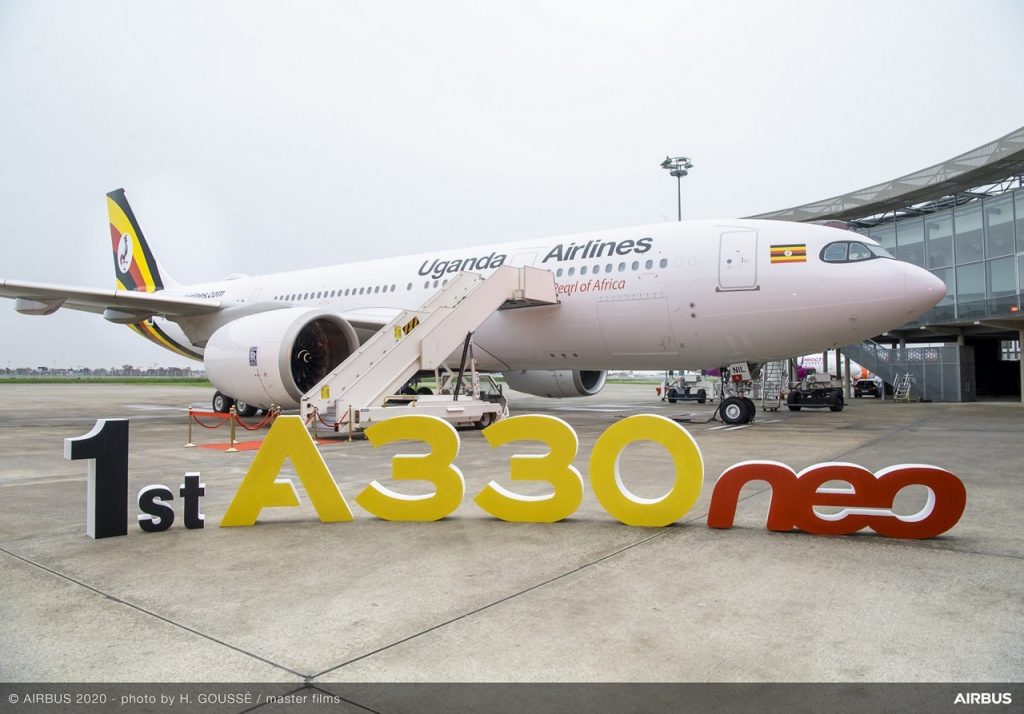Rolls-Royce celebrates new customer in Uganda Airlines

British aircraft propulsion systems maker Rolls-Royce today joined Airbus to celebrate the delivery of Uganda Airlines first widebody aircraft, an Airbus A330-800neo.
The neo is powered by Rolls-Royce Trent 7000 engines, the latest iteration of the venerable Trent 700 which has been in service for 25 years and has been selected by more than 130 airlines globally.
“We are delighted that Uganda Airlines selected the Rolls-Royce powered Airbus A330neo. Uganda Airlines has a bold vision, and we are proud to be part of that future. This excellent aircraft with Trent 7000 engines will help Uganda Airlines create new connections across Africa and the rest of the world. This delivery adds another new Rolls-Royce customer in Africa, which is a very important market for us,” said John Kelly, Senior Vice President Customers at Rolls-Royce.
The exclusive engine for the A330neo, the Trent 7000 is the seventh in a Trent family that has now accumulated more than 150 million engine flying hours. The Trent 7000, which first entered service in November 2018, draws on more than 50 million flying hours of experience from the Trent 700, the engine of choice for the original version of the A330. The 68-72,000lb thrust Trent 7000 helps the A330neo reduce environmental impact with a 14pc improvement in fuel burn per seat (compared to the A330ceo) and a significant reduction in noise.
Some technical facts on the Trent 7000
Its 9.3 feet-wide front fan sucks in up to 1.3 tonnes of air every second at take-off. Each one of the engine’s 20 titanium fan blades is hollow, with an internal girder structure to maximise strength. They are created using a process called super-plastic forming and diffusion bonding, where a “sandwich” of titanium is heated in an oven while gas is blown into it to ‘inflate’ the blade.
High-pressure turbine blades inside the engine rotate at 12,500 rpm, with their tips reaching 1,200mph, nearly twice the speed of sound. These high-pressure turbine blades operate in an environment where temperatures can exceed 2,000C, higher than the melting point of the blade itself. To protect them, each blade has tiny air holes in it from which “cooling air” (at 700C) is blown to cover the blade’s surface.
Over 25 years, the Trent engine family has accumulated more than 150 million engine flying hours – the equivalent of 390 times the distance to the sun and back. Approximately 3.5 billion people traveling on holidays, business trips and humanitarian missions have been carried on Trent powered aircraft.
UR 404, the Airbus A330neo delivery flight is expected to leave Toulouse at 01.00hrs CET ( 03.00 hrs EAT) on December 22 for a same day arrival in Entebbe at 11.00am local time.
 Cornwell Muleya, CEO of Uganda Airlines, said: “We are delighted to welcome our new Rolls-Royce powered Airbus A330neo into service. The efficiencies of this aircraft, together with Rolls-Royce’s Trent 7000 engines, will help us deliver a great value offering to our passengers.”
Cornwell Muleya, CEO of Uganda Airlines, said: “We are delighted to welcome our new Rolls-Royce powered Airbus A330neo into service. The efficiencies of this aircraft, together with Rolls-Royce’s Trent 7000 engines, will help us deliver a great value offering to our passengers.”
Rolls-Royce pioneered a unique aircraft engine service contract with customers where they pay for the time the powerplant is in service rather than owning the engine as such. This means that should the aircraft be grounded because of problems with the engine, Rolls-Royce compensates for the revenue lost.

 African Heads of state head to South Korea next week for Summit talks
African Heads of state head to South Korea next week for Summit talks
 Trading leads as main source of income for Ugandans
Trading leads as main source of income for Ugandans
 New leadership for bankers’ umbrella as total assets top $12 billion
New leadership for bankers’ umbrella as total assets top $12 billion
 Brussels Airlines to announce Nairobi service
Brussels Airlines to announce Nairobi service
 SITA promises enhanced travel experience after Materna acquisition
SITA promises enhanced travel experience after Materna acquisition
 Saudia’s 105 aircraft order stretches A320neo lead over rival Max
Saudia’s 105 aircraft order stretches A320neo lead over rival Max
